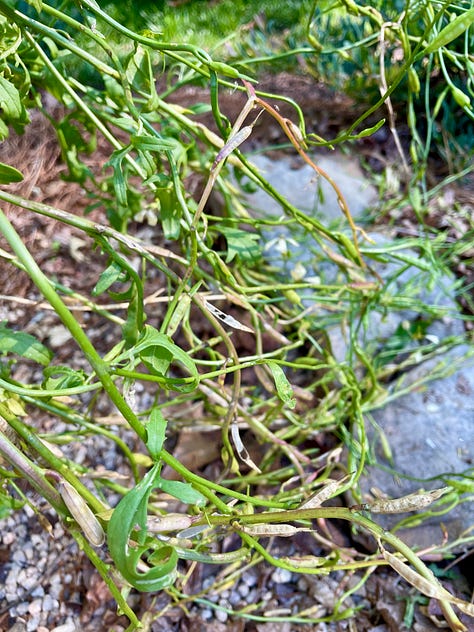Value the Full Lifecycle of Your Plants
Tip No. 2 for Developing a Green Thumb
I don’t believe anyone is born with a green thumb, but there are some things “green thumb people” do that other people do not. In this series, I’m sharing the Top 10 things I’ve learned to do that have developed my green thumb.



Green Thumb Tip No. 2: Value the Full Lifecycle of Your Plants
The bolted leafy greens. The seedheads of dried up flowers. The roots of the legumes. Look for their full potential.
One thing I’ve learned is to embrace rather than bemoan the senescence of plants—especially the cool season, early bolters that flower before a lot of other things and attract pollinators before your marigolds bloom. They may seem past their prime, but there are reasons to leave them in the garden for a while.
Take bolted radishes and cilantro, for example. They both make pretty filler flowers for rustic bouquets, and when the flowers fade, you get radish pods (which taste like—you guessed it—radishes!) and coriander seeds for your spice drawer.
In both of those examples you can let the seeds dry out right there in the garden and then harvest and store for next year’s planting.
Once the arugula above bolted, I left the full patch in flower through the early spring when little else was in bloom. And then as I needed the space for planting tomatoes, I cut back all but one stem that was going to seed and left it there to dry out.
I cut the English peas down at soil level and left their nitrogen-fixing roots in the soil to do their work.
I leave dried out echinacea and sunflowers standing for the birds to browse for seeds.
Many varieties of kale are biennial: So you can cut them back to a stump when they bolt and they’ll come back for another go-round.
Those pretty English cottage gardens everyone loves are largely made up of self-sowing flowers that have to be left standing (haggardly) until they develop and drop seed for next year.
Seasoned gardeners find the value the full life span of the things they plant.
Read the other articles in this series:
I share more tips like this to help you become a gardener in my zine “The Uncomplicated Gardener” available from Good Printed Things!

